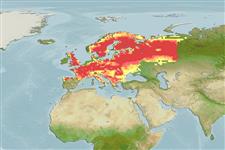Classificação / Names
Common names from other countries
Referência principal
Tamanho / Peso / Idade
Max length : 60.0 cm TL macho/indeterminado; (Ref. 556); common length : 30.0 cm TL macho/indeterminado; (Ref. 556); Peso máx. publicado: 6.7 kg (Ref. 6368); Idade máx. registada: 14 anos (Ref. 556)
Length at first maturity
Lm ? range ? - ? cm
Ambiente
; Água doce; estuarina bentopelágico; pH range: 7.0 - 7.5; dH range: 20 - ?; não migratória; intervalo de profundidade 15 - ? m (Ref. 30578)
Clima / Intervalo
Temperate; 6°C - 18°C (Ref. 2059), preferred ?; 70°N - 42°N, 6°W - 66°E
Distribuição
Europe: Barent Sea basin west of Urals, Caspian, Black, Baltic, White and North Sea basins, Atlantic westward to Loire drainage; Rhône drainage; northern Adriatic basin east to Soca drainage. Introduced over most of southern and central Finland. Appendix III of the Bern Convention (protected fauna).
Países | Áreas FAO | Ecossistemas | Ocorrências | Introduções
Descrição breve
Espinhos dorsais (total): 5 - 8; Raios dorsais moles (total): 12-17; Espinhos anais 3-4; Raios anais moles: 9 - 10; Vértebras: 57 - 61. Distinguished from Thymallus arcticus by the following unique characters: maxillary usually reaching anterior margin of eye; pelvic fin grey, lacking red stripes; body without red spots; dorsal fin greyish, with parallel rows of round dark spots; gill rakers 19-30, averaging about 24-26 (Ref. 59043). Caudal fin with 19 to 21 rays (Ref. 2196).
Categoria na Lista Vermelha da IUCN (Ref. 115185)
Ameaça para o homem
Harmless
Utilização humana
Pescarias: espécies comerciais; Aquacultura: espécies comerciais; peixe desportivo: sim; Aquário: Aquários públicos
Mais informação
ReferênciasAquaculturaPerfil para aquaculturaEstirpesGenéticaFrequência dos alelosHereditariedadeDoençasProcessamentoMass conversion
Ferramentas
Relatórios especiais
Descarregue XML
Fontes da internet
Estimates of some properties based on models
Phylogenetic diversity index
PD50 = 0.5001 many relatives (e.g. carps) 0.5 - 2.0 few relatives (e.g. lungfishes)
Nível Trófico
3.1 ±0.42 se; Based on food items.
Resiliência
Médio, tempo mínimo de duplicação da população 1,4 - 4,4 anos (K=0.12-0.26; tm=2-6; tmax=14)
Vulnerabilidade
Moderate vulnerability (41 of 100)
Categoria de preço
